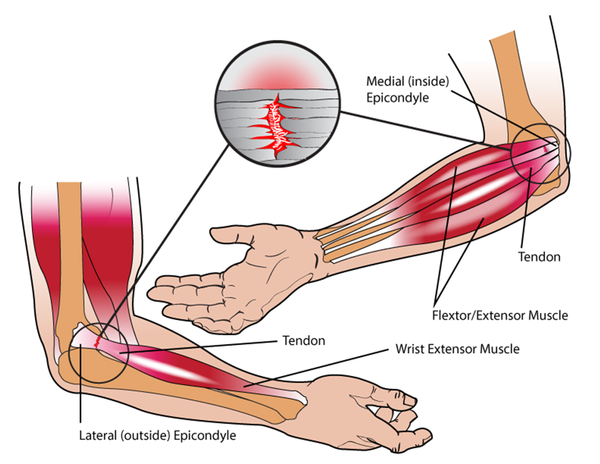Posted by Judith Winer on Oct 31, 2016
Simeon Asher - Treating Tennis Elbow
Lateral Epicondylalgia (Tennis Elbow) is more common than Medial Epicondylalgia (Golfer's Elbow) by a ratio of 9:1
Lateral Epicondylalgia (Tennis Elbow) can start as an annoying ache but rapidly degenerate into a debilitating problem, with pain on gripping, opening bottles or even on shaking hands. Most people are surprised by just how bad the pain can be.
Elbow pain is often associated with ‘trigger points’ in the muscles of the lateral epicondyle of the elbow; especially the Lateral Head of Triceps and the Extensor Carpi Radialis Brevis tendon (1‐2 cm distal to its attachment on the lateral epicondyle).

Lateral Epicondylalgia is more common than Medial Epicondylalgia (Golfer's Elbow) by a ratio of 9:1 and although mostly referred to as Lateral Epicondylitis, LE is generally NOT an inflammatory condition.
Microscopic evaluation of the tendons does not show signs of inflammation, but rather angiofibroblastic degeneration and collagen disarray. Light microscopy reveals both an excess of fibroblasts and blood vessels that are consistent with new blood vessels (angiogenesis).
LE is in fact most often due to repetitive micro-tears in the zone especially where the tendon of the muscle meets the bone (musculotendinous junction) - this is because the tendons are relatively close to the tendon insertion.
In this trigger point video (above) we look at the most commonly used treatment techniques for LE.
Do not perform these trigger point therapy techniques unless they fall within your professional scope of practice.
This webinar is intended to be used for information purposes only and is not intended to be used for medical diagnosis or treatment or to substitute for a medical diagnosis and/or treatment rendered or prescribed by a physician or competent healthcare professional. This information is designed as educational material, but should not be taken as a recommendation for treatment of any particular person or patient. Always consult your physician if you think you need treatment or if you feel unwell.
Комментариев нет:
Отправить комментарий